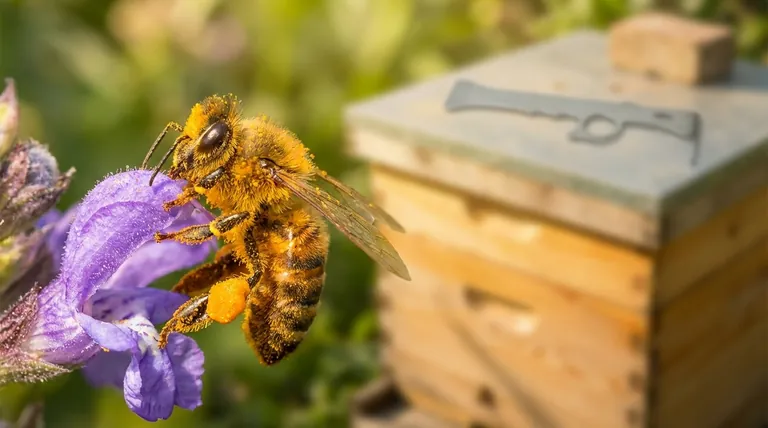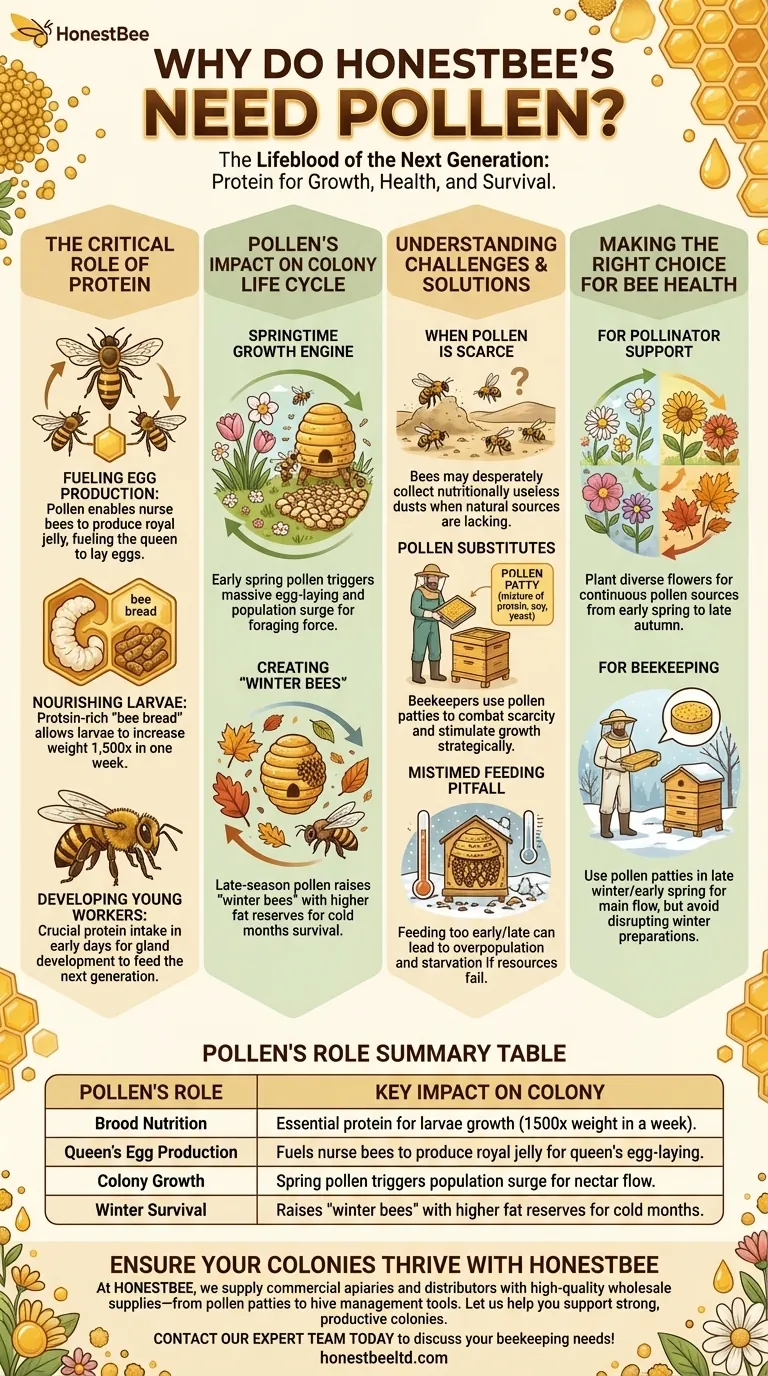At its core, pollen is the lifeblood of the next generation of honey bees. It serves as the colony's primary source of protein, fats, vitamins, and minerals, which are indispensable for raising young bees, known as brood. While nectar and honey provide the carbohydrates for adult bee energy, a colony cannot raise its young or grow its population on sugar alone.
While honey fuels the daily work of adult bees, pollen builds the very foundation of the colony's future. It is the essential protein source that enables a queen to lay eggs and nurse bees to raise the next generation, directly dictating the colony's health and ability to grow.

The Critical Role of Protein in the Hive
A honey bee colony operates like a complex organism, and pollen is the key nutritional input that drives its growth and development. Its function goes far beyond simple food.
Fueling the Queen's Egg Production
A healthy queen bee is an egg-laying machine, but she cannot produce eggs without a protein-rich diet. Worker bees feed the queen royal jelly, a substance they produce from glands in their heads.
The development and function of these glands are entirely dependent on the nurse bees consuming pollen. Without sufficient pollen, nurse bees cannot produce enough royal jelly, and the queen's egg-laying will slow or stop completely.
Nourishing the Larvae
Honey bee larvae are incredibly vulnerable and have voracious appetites. After hatching, they are fed a diet of brood food, which is derived from pollen and nectar.
This protein-rich "bee bread," a mixture of fermented pollen and honey stored in cells, is what allows a larva to increase its body weight 1,500 times in under a week. A lack of pollen leads directly to larval starvation and the collapse of the colony's future workforce.
Developing Young Worker Bees
Even after a bee emerges from her cell as an adult, she is not fully developed. Young worker bees must consume large amounts of pollen in the first few days of their lives.
This protein intake is crucial for developing the very glands they will later use to feed the queen and the next round of larvae, ensuring the cycle of life continues.
Pollen's Impact on the Colony Life Cycle
The availability of pollen dictates the rhythm of the entire colony throughout the year, acting as a powerful signal from the environment.
The Springtime Growth Engine
The first pollen of early spring is a critical trigger for the colony. Its arrival signals that resources are becoming available, prompting the queen to ramp up egg-laying dramatically.
This surge in brood production builds the massive forager workforce needed to collect the primary nectar flow later in the season. The size of this workforce is directly tied to the amount of pollen available in the spring.
Creating "Winter Bees"
The pollen collected in late summer and autumn is used to raise a special generation of "winter bees." These bees have higher protein and fat reserves in their bodies, allowing them to live for several months through the winter, compared to the 4-6 week lifespan of a summer bee.
This winter generation is responsible for keeping the queen warm and initiating brood-rearing in the final weeks of winter, using the colony's stored pollen.
Understanding the Challenges and Solutions
The absolute dependency on pollen creates significant challenges for bees, especially when natural sources are compromised.
When Pollen is Scarce
A honey bee's instinct to gather pollen is so strong that when it is unavailable, they have been observed collecting nutritionally useless dusts like sawdust or coffee grounds.
This desperate behavior highlights the critical nature of their need. While honey bees can travel great distances to find resources, a widespread lack of pollen-producing flowers is a severe threat.
The Role of Pollen Substitutes
To combat scarcity or to stimulate growth at strategic times, beekeepers often provide pollen patties. These are mixtures of protein-rich ingredients (like soy flour, brewer's yeast, and actual pollen) and sugar syrup.
Placing these in a hive encourages the queen to lay eggs and enables nurse bees to raise brood even when natural pollen is not available.
The Pitfall of Mistimed Feeding
Using pollen substitutes requires careful timing. Feeding a colony too early or too late in the season can create a large population of young bees and brood that the colony cannot support.
If a cold snap returns or the nectar flow fails, this large population can quickly consume all the hive's resources, leading to starvation.
Making the Right Choice for Bee Health
Understanding the role of pollen is crucial for anyone interested in bees, from gardeners to professional beekeepers.
- If your primary focus is supporting pollinators: Plant a diverse range of flowers that bloom sequentially from early spring through late autumn to provide a continuous and varied pollen source.
- If your primary focus is beekeeping: Use pollen patties strategically in late winter or early spring to build colony strength for the main nectar flow, but be cautious with feeding that could disrupt the colony's natural preparations for winter.
Ultimately, recognizing pollen as the engine of bee reproduction is fundamental to ensuring the health, growth, and long-term survival of a honey bee colony.
Summary Table:
| Pollen's Role | Key Impact on the Colony |
|---|---|
| Brood Nutrition | Essential protein for larvae to grow, increasing body weight 1,500x in a week. |
| Queen's Egg Production | Enables nurse bees to produce royal jelly, fueling the queen's egg-laying. |
| Colony Growth | Spring pollen triggers population surge, building the forager workforce for the nectar flow. |
| Winter Survival | Late-season pollen raises "winter bees" with higher fat reserves for cold months. |
Ensure your colonies thrive with the right nutrition and equipment. At HONESTBEE, we supply commercial apiaries and beekeeping equipment distributors with high-quality wholesale supplies—from pollen patties to hive management tools. Let us help you support strong, productive colonies. Contact our expert team today to discuss your beekeeping needs!
Visual Guide

Related Products
- HONESTBEE Advanced Ergonomic Stainless Steel Hive Tool for Beekeeping
- Professional Dual-End Stainless Steel Hive Tool for Beekeeping
- Professional 3-Bar Frame Grip with Integrated Hive Tool
- Full Set Beekeeping Electronic Bee Venom Collector Machine Device for Bee Venom Collecting
- Plastic Chinese Queen Grafting Tool for Bee Queen Rearing
People Also Ask
- What is the hole in a hive tool for? A Multi-Tool for Apiary Repairs and Maintenance
- What is a hive tool and what are its uses? Master Your Hive Inspections with the Essential Beekeeper's Tool
- What are the features of a regular hive tool? The Essential Multi-Tool for Every Beekeeper
- What tools are used for cleaning frames? A Beekeeper's Simple 4-Tool Guide
- Why do hive tools have a hole? Unlock the Secret to Efficient Beekeeping



















